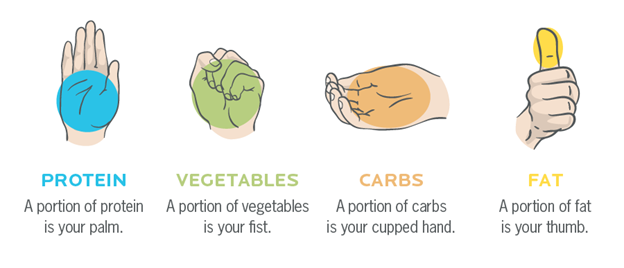By Donna Dunston, MS, LN, WIC Nutrition Coordinator

There it is! In your face all day now that we are working from home. The dreaded refrigerator. The holy grail that holds all things dear to us. FOOD!
Working from home, being more isolated and anxious than usual, or just being out of our regular routine of going to the gym, running errands on Saturdays, and taking the children to the park has contributed to a more sedentary lifestyle.
Having access to food all day quickly leads to a few extra pounds. Consuming an extra 100 calories a day for a year without exercising can lead to a weight gain of 10 pounds!
One way to tackle this challenge is to consume the recommended portion. To do this, we need to know the difference between a portion and a serving:
- A portion is the amount of food that you choose to eat for a meal or snack. You can decide.
- A serving is a measured amount of food or drink, such as one slice of bread or an 8-ounce cup of milk. Serving sizes can be found on nutrition labels.
Over the past 20 years, everyone has noticed that food portions have gotten larger. Everything is Super-Sized, Jumbo or a Whopper! Our new normal in portions has resulted in larger waist size and increased weight.
Portion Comparison
| 20 Years Ago | Today | |
| Coffee | 8 ounces (45 calories) | 16 ounces (at least 350 calories) |
| Muffins | 1.5 ounce (210 calories) | 4 ounces (500 calories) |
| 2 Slices of Pizza | 500 calories | 850 calories |
| Chicken Caesar Salad | 1.5 cups (390 calories) | 3.5 cups (790 calories) |
| Chocolate Chip Cookie | 1.5 inches (55 calories) | 3.5 inches (275 calories) |
Here are a few examples of how to measure appropriate portion size:
- 3 ounces of meat = woman’s palm or deck of cards
- 1 medium fruit/potato = size of a tennis ball
- 1 cup of cooked pasta = size of a baseball
- 1.5 ounces of cheese = size of a 9-volt battery
- 1 ounce of lunch meat or cheese = one slice
When in doubt, use your hand to measure:

More Tips for Portion Control:
When eating at home: Serve the food on individual plates. Keeping the excess food out of reach may discourage overeating. Cook one portion per person when possible.
When eating in front of the TV: Place the amount you plan on eating (one serving) in a bowl instead of eating out of the package.
When eating out: Split entrees or ask the waiter to box half of your meal before bringing it to the table.
Lastly, always remember “out of sight, out of mind.” Instead of keeping candy or cookies on your countertop, place fresh fruit in a bowl. High-calorie snacks should ideally not be part of our grocery shopping; if they are, keep them WAAAY in the back of the refrigerator, freezer, or cabinet. Healthier foods should be placed in the front or at eye level so you are more likely to grab those first.
Bon Appetit!

